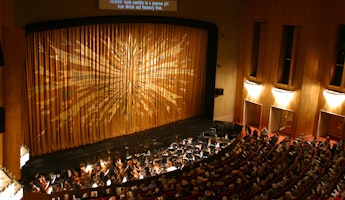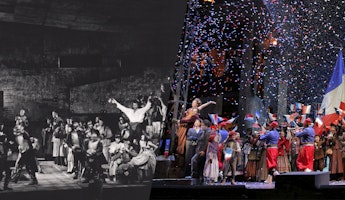Blog
May 20, 2022
"Aida": A Note from James Conlon
AIDA: A CULMINATING GRAND OPERA, THE THIRD OF A MATURE TRILOGY, AND A (NOT SO) FINAL CHAPTER
Giuseppe Verdi, with his hard-nosed realism, believed that happiness was difficult to attain and, if attained, was fleeting at best. His operas tell us that repeatedly. And yet we yearn to hear them, over and over again. Through their music and pathos, we experience our own lives and seek our own transcendence, the same way we do when we listen to Bach, Mozart, Beethoven and Wagner. Only the message is very much that of Verdi himself, in his unmistakable voice.
Verdi's opera Aida enjoyed an almost unparalleled popular international success following its premieres in Cairo and Milan (in 1871 and 1872, respectively). It reached ten cities—including New York, Berlin, Vienna and Buenos Aires—within two and a half years; 20 cities within three years; 30 within four; 40 within five; and 50 within ten years. Since its Metropolitan Opera premiere in 1886, it has been given there 1,175 times, second only to La Bohème.
Verdi's monumental classical opera also marks an exclamation point in his life. We know it was an interruption and not an ending. But at the time, Verdi, and others, thought of it as the last one: his magnum opus.
Aida has been described as a "ceremonial opera." Its monumentality was almost inborn, as it It was commissioned for the opening of the Suez Canal. It is built of large granite-like architectural blocks, which remain unmoved while the personal tragedy of the protagonists, who may seem small, is played out. This opera sums up so many of Verdi's innovations and developments. It is noteworthy that his next work, the Requiem (1874), is fully ceremonial and static.
With its ritualistic structure, the temple scene in the second scene of the first act (in which absolutely nothing "happens") and the triumphal scene with its massive architecture, the way forward to the Requiem is paved. In the fourth-act judgment scene, the terrain for the confrontation with death and a Last Judgement is set.
The purposefully static, monolithic and grandiose architecture is reflected by and abets the King and High Priests, the rigid and severe authoritarian rulers. It is the composer's final encounter with grand opéra. Verdi progressed through his entire career with works alternating between innovations and their consolidation. With Aida, he consolidates the vast new territory pioneered in Don Carlos, and in many regards it is his most classical work, summing up and perfecting a magnum opus. Had he not lived long beyond contemporary life expectancy, it might well have been his final work (and he was not to produce another opera for 15 years) and it has all of the gravitas of a final testament. But as we will see, it was not the final chapter. He continued to innovate even in this work that appears to be a summation. The hints of what was subsequently to come are readily evident.
For many, it is an iconic opera, the very emblem of opera, its popularity unassailable. It has never been absent from the world stage. Yet it too was subject to the opprobrium and disdain of many. What makes Aida a great opera? What makes a work of art an icon? I have no better answer than: it just is. Theory does not define opera. Aida is a great work that defines itself. As such, it has come to exemplify the quintessential opera and finds itself in Western culture's Parthenon.
The words of Umberto Eco, writing on the functions of literature (equally applicable to classical music) come to mind.
"We are surrounded by intangible powers, (including) literary tradition...the power of that network of texts which humanity has produced...for its own sake, for humanity's own enjoyment---and which are read for pleasure, spiritual edification, broadening of knowledge or maybe just to pass the time."
To "explain" and/or argue for Aida's relevance is to do the same for the Beethoven 5th Symphony or Pathétique Sonata, da Vinci's Last Supper or Shakespeare's Hamlet. None of these works, or thousands of others, is obliged to answer for its contemporary relevance. It is for us to figure it out, and to our disadvantage not to do so.
Although Verdi was politically prominent, a national hero for the unification and emergence of the new Italian state, he was not interested in "political" art. Yes, he tells stories with historical characters, often sophisticated ones, but he is never writing to make a critical point about those histories, nor is he attentive to or concerned with historical details and accuracy. He is interested in a good story. He may dress up his characters in various quasi-historical garbs, but in the end, they always revolve around tragic love stories: a soprano and tenor in love, a baritone and/or a mezzo-soprano who oppose that love, and a bass who looks on (benevolently or otherwise) as some sort of authoritative figure.
Aida is yet another example of the leading myth and governing model of the Italian 19th century, that of Romeo and Juliet: ill-fated love, tragically contending with larger obstacles and powerful forces. The usual suspects are all to be found in Aida: the outsider, the marginalized, the unbending authoritarians; the competing demands of love and duty; loyalty to the tribe; love and jealousy; and the conflict between father and child. Reminiscent of Luisa Miller and Rigoletto, we have two fathers: the kings of Egypt and Ethiopia, and their princess daughters, Amneris and Aida, respectively.
Verdi's operas also concern themselves with spirituality, an afterlife, and religion as an institution. If not an outright atheist, he was at least an agnostic, and most definitely anti-clerical and institutional religion. His works sometimes deal with the tension and contradiction between organized religion and inner spiritual sentiments. The religious is more than just background noise in his early-period works: Nabucco, 1842; I Lombardi alla Prima Crociata, 1843, and its revised version Jérusalem, 1847; and Stiffelio, 1850. The latter, a fascinating portrait of a Lutheran minister and his adulterous wife, which directly preceded the middle period trilogy of Rigoletto, Il Trovatore and La Traviata (1851-1853), did not catch on with the public and has (undeservedly) remained in the shadows, despite recent revivals.
But with the arrival of La Forza del Destino (1862/1869), Don Carlos (1867/1884) and Aida (1871/1872), religion as a force with which to be reckoned comes to center stage. I am grateful to Professor Simon Williams of UCSB for sharing his idea of referring to these three operas as the "late period trilogy,” a concept that I had never heard before, but one which is extremely apt.
Though the three works are very different from one another, they all deal in a very characteristic way with Verdi's view of religion and spirituality. Forza: religion versus secular society; Don Carlos: religion versus the state; and Aida: religion as state. The three soprano protagonists, through their capacity to love, will all give us a glimpse of transcendence through their example in their lives, and an opening to a higher order, through their deaths.
Forza, Verdi's only epic opera, is Shakespearean in its fluid mixture of tragedy, melodrama, romance, action and comedy. Its "slices of life" series of vignettes are weighted by the omnipresence of Roman Catholicism. That element is incorporated in the centrality of the monastery, where Leonora seeks both physical refuge and spiritual peace. The clergy is represented by contrasting "types," the wise and kindly spiritual father Padre Guardiano, and the crude, petty, unenlightened and self-interested (though delightfully comic) Padre Melitone. Verdi suggests the monastic life as spiritual solace for the world weary. Forgiveness and acceptance are proposed as a foil for vindictiveness and revenge (staples in 18th-century melodrama) and, in the end, the force of destiny will prove inescapable, monastery or no, and take the lives of all the members of the De Vargas family.
Don Carlos is a richly pseudo-historic portrait of the Spain of King Philip II. The personal love, and the vision of transcendence, is again brought forth through the extraordinary moral character of Queen Elisabeth de Valois, third wife of Philip, and stepmother to Don Carlos. They are in love. The dynamics of politics is the struggle for dominance between the state, (King Philip) and the church (the Grand Inquisitor). They are locked in a power struggle, a strangulating embrace of common beliefs and conflicting interests. Elisabeth, though caught in the web of other's weaving, incorporates an authentic spirituality and faith which starkly contrasts itself with that of organized religion.
Aida, born an Ethiopian princess, has lived as the slave of the king of Egypt's daughter, Amneris. She is also caught between love of her father, her people and her homeland, on the one hand, and her love for their common enemy Radames, the Egyptian military hero. The enforcers are the high priests, led by Ramfis. Although the king is considered a god, religion is the state, and the inexorable will of the high priests crushes the humanity of the ill-fated lovers as well as that of Amneris. It is Aida herself who radiates with the light of transcendence.
All three operas end with exquisitely beautiful "love" music, inspired and led by the soprano, a shining godly light which completely contrasts itself with the power mechanisms of the state religions. Forza ends, in the second and more spiritual Milanese version, with a trio led by the Padre Guardiano. Leonora lifts our gaze to the afterlife. Shimmering violin tremolos in the highest reaches of the orchestra waft us away from earth. Not for the first time, Verdi discovered the power of a soft landing at the end of his operas. He was to use it again, in one version of Don Carlo, after Elisabeth and Don Carlo bid an earthly farewell. (A pianissimo duet! No one dies!). They will meet "up there, in a better world."
He was to surpass himself with the final love duet between Aida and Radames. This final duet's delicate, diaphanous and ethereal pianissimo is unsurpassed. Amneris's whispered prayer turns it into a trio and sets the stage for the Requiem. It too will end with a similarly murmured prayer. Verdi is in the process of taking leave of those thunderous climaxes that characteristically accompanied the final curtain, as it came crashing down on the just deceased sopranos of his melodramas. Aida will end with the transformation of souls into higher beings, as if it were an “Italian Liebestod” (Wieland Wagner's comparison). The orchestra inhabits the upper register, high violins, and soft shimmering strings in a flat key, all of which he has used to extraordinary effect in Forza and will again in the Offertorium and Lux Aeterna sections of the Requiem. The afterlife is envisioned as a distant but radiant light.
And with this late period trilogy, Verdi closes the door on the centrality of religion in his operas. Two years later, all of that spiritual energy finds its metamorphosis in the Requiem.
Despite that, Aida has also been disdained and dismissed, particularly in the late 19th century by the Wagnerites and German classical music lovers. Critics have rejected it as vulgar, pompous, dramatically inert and just plain bad. The famous triumphal march was considered trash by some (Verdi didn't completely disagree with that viewpoint) but nevertheless can be recognized by people who have never attended an opera. That odor of condescension is still emitted in many quarters of the world today.
In the late 20th century, both Aida the opera and Verdi the person came under withering criticism by Edward Said for its exemplification of "orientalism,” for all that is and was wrong with European colonialist arrogance. The cinematic tastes of Hollywood and Cecil B. DeMille's productions encouraged the attention to Aida's potential for spectacle and further away from its essence. Now, in the 21st century, some are wont to see it fail on the test of political correctness or for being a "museum piece."
It is beyond the scope of this article to give all of these these questions the time and space that they merit. This is more simply a study of Verdi's musical art. To those who dismiss opera in general and Italian opera specifically, I have nothing to say on this occasion (and I doubt anyone who falls under that category is still reading this article). But I would need to remind all, that Verdi was a man of the people, who wrote for the public. He did not care about his critics, nor did he write for them. He wanted his operas to be loved and enjoyed by the public. In this, he succeeded as few others in history.
Aida has been criticized for both being too Egyptian, and not Egyptian enough. Despite the contributions of the great French Egyptologist, Auguste Mariette (1821-1881), the story could have taken place anywhere and nowhere. What served Verdi's needs was something at a great remove from the present, both temporally and geographically: once upon a time in a Never Never Land. There is almost nothing historically accurate about it. Verdi didn't care about history and therefore, I think, nor should we. Placing the story in a theocratic society excluded any locale that was under the domination of the Roman Catholic church. This story could only be told about a culture that would elicit no objection from ecclesiastical authorities. Verdi, quintessentially Italian, did not seem to be concerned with any Egyptian sensibilities, nor did he travel to Cairo for the premiere. What he did care about were stories about and which provoked powerful emotions.
Peter Conrad sums up Verdi’s art in his brilliant book Song of Love and Death:
“Verdi set the entire world to music. His operas encompass the theocratic ancient Egypt of Aida and the bigoted Babylon of Nabucco, the imperial Spain of Don Carlos and the licentious Italian Renaissance of Rigoletto, the provincial German courts of Luisa Miller and the contemporary Parisian demimonde of La Traviata. In him the operatic world theater... becomes truly global. The composer of Macbeth, Otello and Falstaff is opera's Shakespeare: Verdi the populist is an expert on the human heart, who commiserates with the slave Aida, the courtesan Violetta and the cheerily dishonorable Falstaff, with the wandering mendicants of La Forza del Destino or the universal chorus whispering its prayer for peace in the Requiem. Like the chameleon Shakespeare, Verdi hears everyone at once and distributes music impartially to all... His ensembles compound opposite emotions, as if a god were listening to the polyphonic hubbub of the human race. In the quartet from Rigoletto, Gilda's lament and her father's curses, the Duke's philandering refrain and Maddalena's chuckling patter entwine and overlap; musically they're equivalent, and while they are singing, Verdi withholds judgment.”
It is almost impossible to draw any conclusions about Verdi's politics, prejudices, philosophies or his intimate and personal life from the evidence of his operas. (His revised version of Simon Boccanegra contains the one shining testament to social idealism.) He is as inscrutable and unknowable as Shakespeare. He does not moralize. We only know his characters; we do not know him. We know he likes subjects that tell the story of outsiders and society's outcasts and victims (Azucena, Rigoletto, Violetta, Aida, Don Carlo, Don Alvaro de Vargas, Otello). He pits patriotic or societal duty's demands against those of love. We know the stories will end tragically, but Verdi seems to want us to identify with the protagonist and experience their deaths as personal.
We know we will see love, jealousy, hate, compassion and kindness, violence and cruelty. We will see and hear the human condition.
And all the while, Verdi is sculpting and constantly modifying the musical tradition he had inherited and serving the theater and drama with infinite genius and dedication. Although in many respects, Aida seems to suggest a final, glorious, summation of his art, more than a few hints are evident about what have come to know of him 20 years into the future. The triumphal scene in Aida is both the apex and the end of grand opéra. The judgment scene sums up and ends Verdi's depiction of the cruelty and rigidity of the priestly class. Most important, the scene and even the complete act is now the basic unit. Even though relatively vestigial forms (the aria, the cabaletta, the cadenza) are still to be found, they have been subsumed into a whole and shorn of their applause grabbing endings. The uninterrupted flow of music, and the fluidity of the expressive text, is now virtually complete, and the ground has been prepared for Otello. The closure in this process, equally important to drama and plot, and Aida's construction is nearly perfect.
In Aida's final bars, the afterlife is envisioned as a faint radiant light. Verdi, having completed his most classical and monumental opera, leaves the world of grand opéra, closes the door on much of his past, and opens the way to the future. Although it seemed like the final word... there was an afterlife first to its epilogue: the Requiem mass, then, revisions of Don Carlos and Simon Boccanegra and, much later, the two masterpieces of his old age, Otello and Falstaff. What the world would have missed, if Verdi had indeed followed his inclinations, and remained silent after Aida!








/03-cosi/_dsc0996_pr.jpg?format=auto&fit=crop&w=345&h=200&auto=format)















